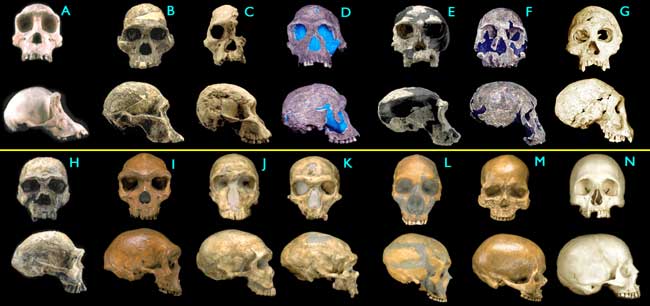Ok, please help me understand, this article say we are not apes but we have a common ancestor, so who is right? Why invent a contradiction? The article says "Humans haven't descended from these apes."
Humans did not descend from the modern chimpanzee species as we know it today, but that species is our closest living relative, a "brother" where no other extant species is closer than "cousin."
But the "father" species, the thing at the branch point if you trace either line back, was an ape, too. What did it look like? A lot more like a chimpanzee than like us. We're the ones who changed a lot. We know. We have the record of the changes.

From here.
The upper right skull is a modern chimp. The next thing over is Australopithecus africanus. It's the most human-like species known of its day, 2.6 million years ago, and thus the best candidate to be on our line of ancestry.
The head still doesn't look incredibly different, despite the actual divergence from the chimp line having happened--on other evidence, mostly molecular--several million years before the owner of that skull ever lived. Most of the differences are below the neck. The australopithecines walked upright much better than do modern chimps. But they still looked a lot like chimps.
We're the apes who have changed the most from the others, but we're still closer at the molecular level to the chimps than the chimps are to orangutans. How do you ignore that? We're on the ape branch, one twig over from the chimps. The chromosomes say it. The DNA says it. The fossils say it.
It doesn't matter what some people would prefer to think.
It gets worse. Yes, our line traces back through apes. Apes arose from monkeys about 30 million years ago. Thus, before 30 million years ago, our ancestors were monkeys. Not any modern monkey species, but recognizeable monkeys.
Monkeys arose from "prosimian" primates like modern lemurs, tarsiers, etc. Not exactly any modern species, but something similar.
Our line traces back through primitive insecitivores, really primitive egg-laying mammals, true reptiles, amphibians, fish, simple chordates, sponge-like multicellulars, and protozoans. Eventually we arrive at something that would have looked like pond scum.
Deal with it!
I ask for assistance in trying to understand and you have to end the story with "
Deal with it! I am trying to understand the evolutionists point in this debate, but am constantly bombarded with things like this
Deal with it!. Is this typical of those who believe in evolution?
Skull of Sahelanthropus tchadensis. Reference is from: Skull Fossil Opens Window Into Early Period of Human Origins  "What's most astonishing is that the facial features are like those that we don't see until 1.8 million years ago in the genus Homo. It is more Homo than australopithecine," he said, referring to the best-known group of hominids, which appeared in East Africa three to four million years ago and whose fossils have provided most of what we know about the earliest human ancestors.
"What's most astonishing is that the facial features are like those that we don't see until 1.8 million years ago in the genus Homo. It is more Homo than australopithecine," he said, referring to the best-known group of hominids, which appeared in East Africa three to four million years ago and whose fossils have provided most of what we know about the earliest human ancestors.
So, is the new skull fossil a hominid—perhaps our earliest known ancestor? "It's very hard to be sure, but I think it's a hominid," said Lieberman. "But whether it was the earliest hominid or the earliest ancestor of anyone living today, we can't tell." New Genus, New Species Michel Brunet of the University of Poitiers in France headed the international team of more than three dozen researchers. They found the fossils—an intact cranium, two lower jaw fragments, and several teeth—at a site in the Djurab Desert where the group has been excavating since the mid-1990s. The researchers compared the ancient skull and related fossils with the fossils of many other known hominids and primates. Based on characteristics such as the tooth type and the thickness of the enamel, the shape and positioning of the head, and the facial features, the team concluded that the creature represented a new genus and species of hominid.
So, now there is a fossil (Sahelanthropus tchadensis) that more resembles man than your Australopithecus africanus and is older than Australopithecus africanus, so where does this leave your answer to "the most human-like species known of its day, 2.6 million years ago, and thus the best candidate to be on our line of ancestry." If this is true, where does this leave this theory that Australopithecus africanus is our closest relative?
So could this Australopithecus africanus be a descendant of Sahelanthropus tchadensis rather than man being a decendant of Australopithecus africanus or could Australopithecus africanus be in a totaly different catagory and not part of mans?

 "What's most astonishing is that the facial features are like those that we don't see until 1.8 million years ago in the genus Homo. It is more Homo than australopithecine," he said, referring to the best-known group of hominids, which appeared in East Africa three to four million years ago and whose fossils have provided most of what we know about the earliest human ancestors.
"What's most astonishing is that the facial features are like those that we don't see until 1.8 million years ago in the genus Homo. It is more Homo than australopithecine," he said, referring to the best-known group of hominids, which appeared in East Africa three to four million years ago and whose fossils have provided most of what we know about the earliest human ancestors.